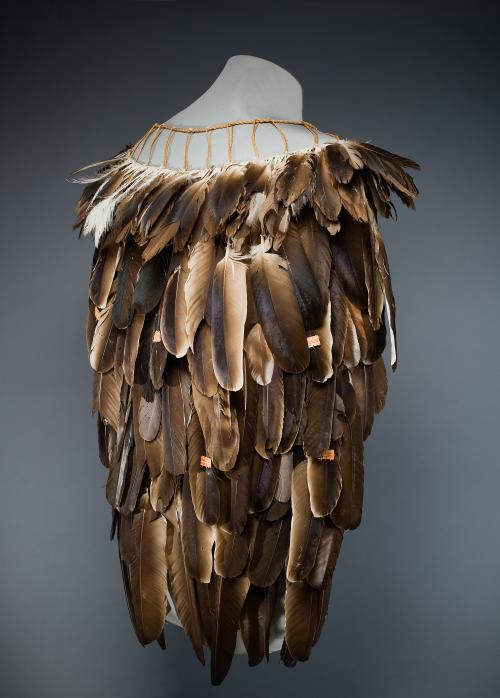 Denver Art Museum (DAM) is home to one of a handful of American Indian condor capes left in the world and you can see it up close in near-pristine condition.
Denver Art Museum (DAM) is home to one of a handful of American Indian condor capes left in the world and you can see it up close in near-pristine condition.
With 10-foot wingspans, condors are the largest land bird in North America. Native American tribes in California, where condors were prevalent during pre-Columbian times, recognized the birds’ power and designated it as sacred. It was thought that by capturing and acquiring the feathers of this stately animal, the wearer could assume the bird’s powers.
The condor shows up in various aspects of American Indian cultures. Its wing bones and quills were used to make flutes and carrying vessels, and the feathers adorned headdresses and other garments.
To the untrained eye, DAM’s cape is flawless, not to mention awe-inspiring. You only have to look at the piece from afar to imagine the amount of work and detail that went into creating this intricate garb. “The makers would have had to capture and process the bird and plants that were used for its tightly knitted foundation,” says Nancy Blomberg, DAM’s chief curator and curator of Native Arts. “Then, every feather was attached one by one.”
The cape was acquired in 1950 from the Peabody Museum of Archaeology and Ethnology at Harvard University, where a DAM curator was assisting at the time. In the last century the piece has passed through four owners. The Peabody obtained it from wealthy Easterner Lewis Henry by way of renowned collector and dealer Grace Nicholson. This relatively low exchange, always through capable and caring hands, has allowed the cape to maintain its near-perfect condition. Although the garment is part of the permanent exhibit, it is not always on display. Like other priceless antiques, it has to be stored from time to time, so that it will not be damaged by the elements.
Blomberg has a strong connection to the Condor Cape. She was active in the conservation efforts surrounding the nearly extinct bird in the 1980s. “I was part of the last condor watch,” she says, referring to a time in the late eighties when the last of the wild condors were counted and the remaining one captured to be bred in captivity. Back then, there were only 27 remaining in the entire world. Now there are around 500 condors in the wild. Even with the population rising, we are not likely to see Native American people or other artists making pieces like this again. It is illegal to hunt or capture the birds. “This piece is extremely rare,” Blomberg says. “We are fortunate to have the opportunity to see it up close at the Denver Art Museum.”
DAM was one of the first major art museums in the U.S. to develop a gallery for Native American works. Curators in the early 1900s identified the importance of the objects as art. Due to the museum’s location in the West, its size and standing, and capable staff, they were able to develop a comprehensive collection. Today the museum holds more than 18,000 pieces of Native American historic and modern pieces, 700 of which are on display in the 23,000-square-foot gallery.
The gallery is divided by region, and the Condor Cape, which can be traced to the Wailaki tribe of central California, is found on Level 3 of the museum's North Building. Next to it is a modern-day painting by Sacramento artist Harry Fonseca, depicting a coyote wearing the cape. Not only is this authentic cape one of the few left in the world, it’s also among the few remaining Wailaki artworks. Most of the tribe’s physical history was decimated during the Gold Rush.
Photo credit: Artist not known, Wailaki tribe, condor feather cape, late 1800s. Denver Art Museum; Native Arts acquisition fund 1950.



